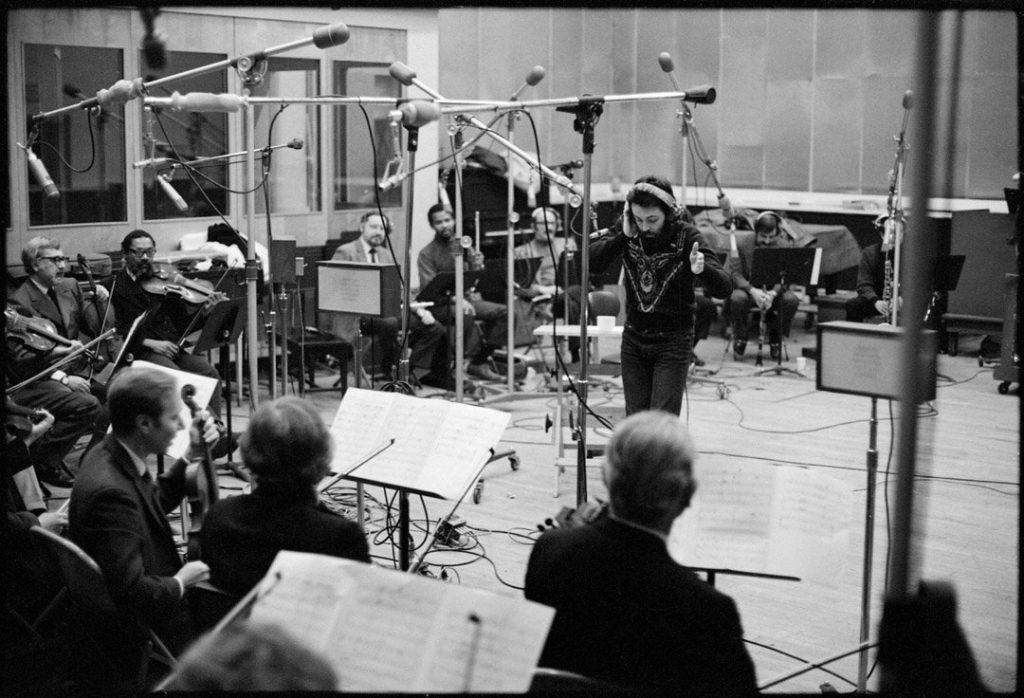"Thrillington" session #3
This image is a cover of an audio recording, and the copyright for it is most likely owned by either the publisher of the work or the artist(s) which produced the recording or cover artwork in question. It is believed that the use of low-resolution images of such covers qualifies as fair use.
- Album Songs recorded during this session officially appear on the Thrillington LP.
- Studio:
- EMI Studios, Studio One, Abbey Road
Songs recorded
1.
2.
3.
4.
5.
6.
7.
8.
9.
10.
11.
Staff
Production staff
- Paul McCartney:
- Producer
- Richard Hewson:
- Orchestration, Arrangements
- Tony Clark:
- Recording engineer
- Alan Parsons:
- Assistant recording engineer
About
The recording of “Thrillington“, an instrumental version of Paul McCartney’s second solo album, “RAM“, had started on June 15, 1971, and had continued on June 16. This day was the third and last day of recording.
Paul McCartney acted only as a producer during those sessions.
He was there the entire time, fine tuning it, speaking with the musicians, just being on top of it and making sure the feel is right. He was definitely in charge. Everyone was secure that if there were any decisions to be made, he would make them.
Tony Clark – Interview with Matt Hurwitz, from “Good Day Sunshine” fanzine – Issue #78 – Quoted in mcbeatle.de
I don’t think I’ve seen Paul quite so happy, away from the responsibility of making and producing his own music – just having a great, great bunch of musicians playing his music. Paul would talk to the musicians, and be the producer in the box, with me engineering, and it all flowed. Paul was bopping around, and feeling great about his music. I reckon we all did.
Tony Clark – from Facebook (Quote taken from McCartney Legacy Volume One, © Dey Street books, 2022.)
From “Good Day Sunshine” fanzine, issue #78:
[…] The next day, on Thursday, June 17, recording took place, all day, in cavernous Studio One, the same one used on numerous occasions by the Beatles to record large orchestras, such as the one producing the climax at the end of “A Day in the Life”. From Hewson’s personal records, it is not known what was recorded this day, though the horn section (comprised of trumpets, trombones and a tuba) are thusfar unaccounted for. They were either recorded this day or in the afternoon on June 15. [Hewson’s diary also indicates, by the way, another meeting with Dick Rowe on this date at 6 p.m. – delayed from 2:30 by the McCartney session.]
The sessions ran quite smoothly over the three days of recording, with rare exception. [Richard Hewson does remember one session player who became so inebriated that he got in his car at lunchtime and went down Abbey Road and smashed into nine cars! “I don’t know whether it was my arranging and conducting that drove him to it!”] Both Hewson and Clark remember the recordings not only fondly, but, for both, as a highlight of their careers. “The excitement of performance for me was just totally there,” remembers Tony Clark. “When music is like that, everybody works at the same level. Most of my career I spend trying to find ways to make magic moments like that.” Clark and Hewson weren’t the only ones enjoying the recording. Tony adds, “What I do remember is that Paul was extremely happy through the whole of the experience.”
The album opens with a collage of orchestra and Swingle chatter and tuning up, taken from the various sessions. “That bit ends with someone saying ‘In the back office with a bottle of scotch,'” recalls Tony Clark. “That’s Jim Lawless, the percussionist.” “Too Many People” then begins with an acoustic guitar, bass, drums and Lawless’s vibraphone, accompanied by some cellos, saxophones and trombones.
In addition, one hears both trumpets and the Swingle Singers in what, today, sounds like a rather dated effect, but which in 1971 was a pioneering sound. “It’s sort of a watery effect; in fact, we just called it ‘the watery box’,” says Clark, referring to the flanged, phase-shifted sound produced by the device heard throughout the record. [“They got this the day we did the session and used it on everything!,” notes Richard Hewson. “You know engineers.”] […]
From “Good Day Sunshine” fanzine – Issue #78 – Quoted in mcbeatle.de
Following the coda of piano break [on the last track, “Back Seat of My Car”], there is a curious sound – that of some water dripping. Believe it or not, the final signature on Paul McCartney’s first instrumental album was provided by none other than one of Abbey Road’s archaic, leaking toilets. Tony Clark remembers, “I remember coming out from the toilet saying to Paul, ‘It’s amazing – it sounds in tune!’ So, of course, Paul goes in himself, and he has a listen.” It was a very late night, in fact during the lengthy mix session which would follow, and, as late nights tend to affect those under their spell, “You just start to get a bit giggly,” says Clark. He listened, Paul listened and Alan Parsons listened, and before anyone knew it, the fellows from the amp room had a microphone set up and four recordings were made, providing a, well, unique ending to the album – in stereo, no less. “And it’s in tune,” adds Clark.
From “Good Day Sunshine” fanzine – Issue #78 – Quoted in mcbeatle.de
The mixing of the album was done on the following day.

Last updated on May 4, 2022